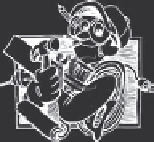Game Development Reference
In-Depth Information
Part II
Buildable Tools
Every programmer likes to get in there and build things. Maybe that's what draws
us to this field. The prospect of building something (and the lack of heavy lifting)
is always a plus.
This part presents a set of tools that you can go off and build for your team,
your company, or your next side project. They are offered with enough detail to
get you to completion but not with the granularity of line-by-line code listings for
the entire app. Let me highlight just a couple of the articles.
We start off Part II with the first article that I wanted for this topic, Chapter 8,
“Real Time Constructive Solid Geometry.” My former colleague and friend, Matt
Baranowski, was working with Sander van Rossen on this topic as a side project at
the same time as the topic idea formed, and it was a perfect match.
This part also contains an article on audio debugging (Chapter 11). Audio is
treated very badly by game companies, I'm afraid. Everyone drools over lovely
graphics and buzz words like screen space, ambient occlusion, or deferred rendering
and forgets that without audio our games are entirely useless or worse...not fun.
To me, audio is akin to shadows. If you have a 3D scene with shadows, you might
never notice them. Without shadows, however, the scene is just plain wrong. We
are very happy we have an excellent article on debugging audio by Simon Franco.
Finally, there is an article on remote version control usage by Mike O'Connor
(Chapter 15). Sometimes we forget that a tool isn't just what we build from scratch,
but it's also the scripts, apps, and programs that interface with the third-party tools
that make our jobs easier. Because more and more game companies have remote
oces, Mike's article will certainly be a valuable read.








